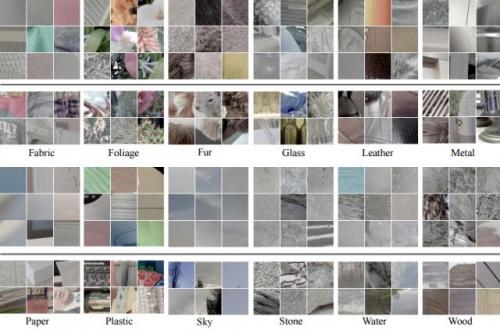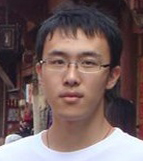Oct 14, 2016

The European Conference on Computer Vision runs Oct. 8-16 in Amsterdam, and UC San Diego's Center for Visual Computing (VisComp) is heavily represented at the international forum that is among the premier academic gatherings on computer vision. Two CSE professors -- VisComp director Ravi Ramamoorthi and Manmohan Chandraker -- were among the authors of eight VisComp papers presented at ECCV 2016.
 Professor Ramamoorthi was the senior author on "A 4D Light-Field Dataset and CNN Architectures for Material Recognition." The paper was joint with colleagues from UC Berkeley as well as recent CSE faculty arrival Manmohan Chandraker and visiting industrial fellow Ebi Hiroaki from Sony, one of VisComp's founding industry partners.) The paper focused on the use of deep learning for recognizing materials using 4D light-field (LF) photography taken with a Lytro Illum 4D LF digital camera. Pictured at right: In recognizing materials, top grids show 4D light-field predicts more accurately than 2D inputs, while bottom grids show 2D more accurate. Conclusion: light-field recognition performs best when object information is missing or vague, so must rely on local texture, viewpoint change or reflectance information available with 4D light-field imagery.
Professor Ramamoorthi was the senior author on "A 4D Light-Field Dataset and CNN Architectures for Material Recognition." The paper was joint with colleagues from UC Berkeley as well as recent CSE faculty arrival Manmohan Chandraker and visiting industrial fellow Ebi Hiroaki from Sony, one of VisComp's founding industry partners.) The paper focused on the use of deep learning for recognizing materials using 4D light-field (LF) photography taken with a Lytro Illum 4D LF digital camera. Pictured at right: In recognizing materials, top grids show 4D light-field predicts more accurately than 2D inputs, while bottom grids show 2D more accurate. Conclusion: light-field recognition performs best when object information is missing or vague, so must rely on local texture, viewpoint change or reflectance information available with 4D light-field imagery."Our main goal [was] to investigate whether the additional information in a light-field (such as multiple sub-aperture views and view-dependent reflectance effects) can aid material recognition," noted the authors, who reported a seven percent boost with the best-performing convolutional neural network (CNN) architecture compared with standard 2D image classification. "Our dataset also enables other novel applications of light-fields, including object detection, image segmentation and view interpolation."
Another of Ramamoorthi's papers was co-authored by colleagues at the University of York (UK), and Sapienza-University of Rome (Italy). University of York's Will Smith was a sabbatical visitor at UC San Diego from York in Winter 2016 when the research took place. The collaborators presented a method for estimating surface height directly from a single polarization image simply by solving a large, sparse system of linear equations. The paper, "Linear depth estimation from an uncalibrated, monocular polarization image," is available online.
In addition to collaborating with Ramamoorthi, CSE Prof. Manmohan Chandraker had a paper at ECCV 2016 on a "Deep Deformation Network for Object Landmark Localization." The work was done while Chandraker was still a research scientist at NEC Laboratories America, before taking up his professorship in CSE earlier this year. His coauthors on the paper were also working in NEC Labs' Department of Media Analytics at the time.
 The Center for Visual Computing is an interdisciplinary research unit, and other faculty with papers at ECCV 2016 included Electrical and Computer Engineering's Nuno Vasconcelos and Cognitive Science professor Zhuowen Tu. Tu has an appointment in CSE as well, so he can supervise CSE Ph.D. students, as he did with first author and CSE Ph.D. student Saining Xie (at left) on a joint paper about "Top-Down Learning for Structured Labeling with Convolutional Pseudoprior." The authors proposed a new method for structured labeling by developing convolutional pseudo-prior (ConvPP) on the ground-truth labels, and they reported "state-of-the-art results on sequential labeling and image labeling benchmarks."
The Center for Visual Computing is an interdisciplinary research unit, and other faculty with papers at ECCV 2016 included Electrical and Computer Engineering's Nuno Vasconcelos and Cognitive Science professor Zhuowen Tu. Tu has an appointment in CSE as well, so he can supervise CSE Ph.D. students, as he did with first author and CSE Ph.D. student Saining Xie (at left) on a joint paper about "Top-Down Learning for Structured Labeling with Convolutional Pseudoprior." The authors proposed a new method for structured labeling by developing convolutional pseudo-prior (ConvPP) on the ground-truth labels, and they reported "state-of-the-art results on sequential labeling and image labeling benchmarks."Learn more about VisComp papers presented at ECCV 2016 on the Jacobs School blog.
Follow future updates on the Center for Visual Computing website.

